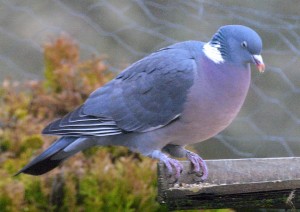 Despite the severe weather in and around Inverness this past winter there have been signs from birds’ behaviour and song that spring is not too far away. This will probably be the affect of the increasing number of daylight hours although the weak sunshine of some days will have played its part. Great tits have been calling with their melodic two tone “teacher-teacher” and they and blue tits have even been investigating nestboxes. This may be exploring the boxes for them to set up territory for future use or to use them as roosting places away from the cold. Wood pigeons have been very much in evidence from their cooing song, the endlessly repeated coo-coo-coo, and their display flight. The flight involves flying up and then planing down with the accompanying one or two claps of their wings. These birds have taken over many gardens and not only take feed off the ground and from bird tables but also from wide trays. The trays are placed under mixed seed feeders to catch any spilt grain but the woodpigeons have learnt the art of balancing to get this free food.
Despite the severe weather in and around Inverness this past winter there have been signs from birds’ behaviour and song that spring is not too far away. This will probably be the affect of the increasing number of daylight hours although the weak sunshine of some days will have played its part. Great tits have been calling with their melodic two tone “teacher-teacher” and they and blue tits have even been investigating nestboxes. This may be exploring the boxes for them to set up territory for future use or to use them as roosting places away from the cold. Wood pigeons have been very much in evidence from their cooing song, the endlessly repeated coo-coo-coo, and their display flight. The flight involves flying up and then planing down with the accompanying one or two claps of their wings. These birds have taken over many gardens and not only take feed off the ground and from bird tables but also from wide trays. The trays are placed under mixed seed feeders to catch any spilt grain but the woodpigeons have learnt the art of balancing to get this free food.
From a wild flower point of view the signs of spring are less noticeable and more subtle. The hazel catkins are lengthening slightly and some of the earliest willows trees are now showing their silky catkins often called “goslings”. Along the shore of Loch Ness in the woodland the dog’s mercury is one of the earliest plants to show green leaves. They are small and inconspicuous and the name comes from it being poisonous and classed as a “dog”. More conspicuous, although not widespread in the Highlands, is the snowdrop that may be seen as an historical part of the countryside so that it is easy to forget that this is almost certainly an introduced wild flower.
Snowdrops are mainly a woodland plant although they will not tolerate dense shade. It is frequent in parks, gardens, road verges and watercourses but one if its favourite places is in churchyards. It is the latter habitat that makes it all the more surprising that it is not more widespread in the Highlands. It occurs in a few places around Inverness and is commoner along the east coast to Aberdeen. Elsewhere it is absent from vast tracts of the countryside with a few records for the coast of Caithness and a couple of sites on the west coast. It appears to be absent from the Western and Northern Isles. In Britain it was known in cultivation since 1597 but not found in the wild until 1778. For a long time it was thought to be, in a few places, native but now it is assumed that they are all alien plants.
Whilst we welcome the flowers as a sign of spring it is also welcome by various early flying insects. Worker bees in a colony dwindle in numbers but with the lengthening days the queen may start to lay her eggs again. The new brood is nourished on the pollen and honey from the previous summer and also on fine days from flights to collect pollen and nectar offered by such plants as snowdrop, gorse and later celandines. Slightly later the willow pollen source is most nutritious for the bees. There are various local names for the snowdrop including Candlemas bells, snow piercer, February fair maids and dingle-dangle. The Gaelic name is Gealag-lair meaning, appropriately, little white one of the grounds. It dos not seem to have been used by any of the Clans as a plant badge possibly because of its small size, limited distribution and its supposed re-introductio
